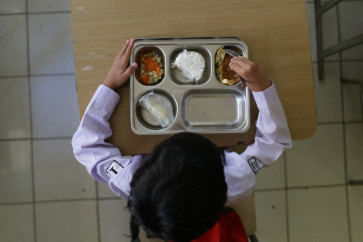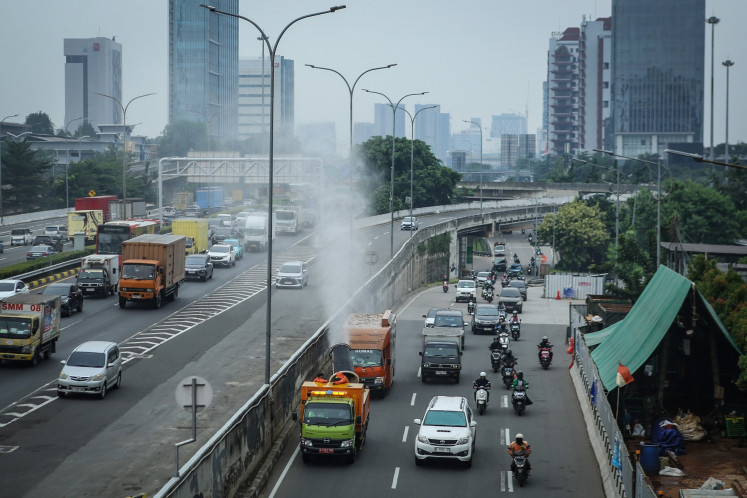Popular Reads
Top Results
Can't find what you're looking for?
View all search resultsPopular Reads
Top Results
Can't find what you're looking for?
View all search resultsFrom Pure Evil to ‘kawaii’: Four solo art shows in one place
Body language: In his solo exhibition, Noël St
Change text size
Gift Premium Articles
to Anyone
Body language: In his solo exhibition, Noël St. John Harnden explores the human body and vivid lines.
A dripping blot of black under one of Marilyn Monroe’s eyes, as if she’s expressing deep sorrow, and a delicious-looking human skull decorated with strawberries and chocolate ice cream steal the attention at four solo exhibitions held at Art:1 in Jakarta.
Depictions of the human body coexist in harmony with vibrant colors and organic curvatures juxtaposed with bold swatches of vividness. The subjects’ facial expressions are obscured, yet their bodies are as expressive as the brightest smile.
These paintings are part of English artist Noël St. John Harnden’s latest solo exhibition, Transformation: Through the Veil, held at Art:1 gallery in Central Jakarta.
The Brooklyn-based Harnden said the concept behind the series of paintings was about “bright colors, form and line”.
“With it being in Indonesia, I thought about using very bright, vivid colors, and sort of combining that with the linear form of the body while also trying to create an interaction between the figure and the background,” he told The Jakarta Post.
Harnden, who received his Bachelor’s degree in fashion design/illustration from the Kingston School of Fashion, said he is experimenting with the meaning of having three-dimensional forms, as well as the difference between the body and the environment.
“I like to juxtapose those and use a lot of colors to really sell the idea of brightness and energy. In a country like Indonesia — where there’s a lot of energy, people and vibrancy — I try to bring my interpretation of that through color and line.”
“Transformation: Through The Veil” is one of four solo exhibitions held at Art:1 simultaneously, done in collaboration with British Council. All four run until Sept. 22.
Another showcase, “High Society” by the London-based graffiti artist Charles Uzzell Edwards, aka Pure Evil, centers on the many famous personalities whom Indonesia’s founding father Sukarno had met during his lifetime, from Marilyn Monroe to Fidel Castro and Mao Zedong.
Edwards explained in a statement that the subjects painted are part of his Nightmare Series, noting drily they “would certainly be very interesting dinner party guests”.
The Nightmare Series itself was borne out of a chance email from a Chinese “copy village”, offering a list of paintings by notable artists it could reproduce, including the likes of Andy Warhol.
“The idea of Warhol’s entire artistic output distilled right down to three 64-by-64-pixel thumbnails of Jackie Kennedy, Liz Taylor and an electric chair became the inspiration for these doomed and dripping celebrity portraits,” he said. “It’s an illustration of the heartbreak and sadness we have all experienced in relationships in the past.”
Edwards’ subjects in the series all depict a dripping blot of black under one eye, as if expressing deep sorrow. This perceived sadness is juxtaposed with varying expressions: a luscious Marilyn, an indifferent Audrey Hepburn with what appears to be a buzz cut and Sukarno himself looking ponderous.
Some of the paintings feature nods to Edwards’ background as a street artist, such as Fidel Castro with graffiti-esque scribbles in the background, Mao Zedong with a Mickey Mouse-esque headpiece and the graffiti-like interpretation of a traditional batik pattern.
The batik pattern is noticeably prominent, as it is applied to three different yet poignant subjects: Sukarno, Mao and Monroe.
Meanwhile, Japan’s Osamu Watanabe showcases what is perhaps Japan’s most well-known cultural export: kawaii (cute) imagery.
Characterized by cutesy and childish characteristics, his aptly titled “Kawaii Aesthetic” exhibition combines animal subjects with resin recreations of sweets that tempt you to lick.
Macabre sweet: Osamu Watanabe's work, titled Heaven Skull Gold, is displayed in one of the four solo exhibitions held at Art:1 in Jakarta until Sept. 22.Watanabe’s signature style of saccharine sweetness reminiscent of the uniquely Japanese Deco-den has been his trademark since 2003, when through the “Sweets Decoration Arts” he mimics real food using fake whipped cream and fruit.
For his exhibition in Jakarta, in Heavenly Messenger, for example, he depicts a deer made out of a cafe’s pastry case, which includes waffles, pudding, macaroons and a cherry on top.
Sweet Cat 2 takes the form of a kitten gazing at the viewer, body composed of individual icing and ears made out of strawberry slices.
Not all of the subjects are cutesy and wholesome. Heaven Strawberry Cream and Heaven Skull Gold depicts the human skull as a macabre subject, albeit toned down with additional decorations like strawberries, chocolate ice cream and even more icing.
In another exhibition, “Intuitive Form”, fellow Japanese Shingo Okazaki explores the potential of non-representative paintings.
Okazaki’s abstract artworks feature a sense of roughness, seen through layers of paper, imperfect lines and quick brushstrokes. Colors are muted, with hints of vivacity infrequently dotting the canvas.
Speaking through an interpreter, Okazaki told the Post he does not have a definite inspiration, instead preferring to draw on his feelings and intuition.
“I’m not the kind of artist who will draw something from what I see, but rather someone who lets out all of my feelings into an artwork. With these, it is an extension of my previous artworks,” Okazaki said, adding that one artwork can be completed in a couple of hours.
“I created my artworks in one go and I’m very happy with the end results. Because they were based on my feelings I do not have an idea about how they will turn out when I start working.” (ste)
Abstraction: Shingo Okazaki's artworks are based on his feelings.— Photos by JP/Josa Lukman













